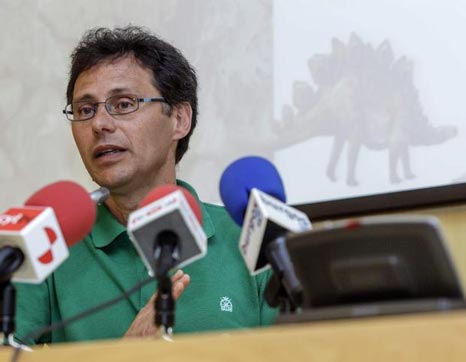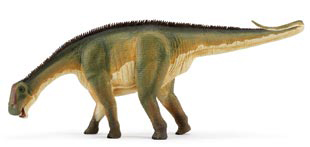Spanish Site – Provides Palaeontologists with the Opportunity to Follow in the Footsteps of Dinosaurs
A site some twenty kilometres south-east of the town of Burgos in northern Spain has provided a team of palaeontologists with an opportunity to study an exceptionally well-preserved collection of fossilised dinosaur footprints. The site, known as Las Sereas part of the Quitanilla de las Viñas trace fossil beds is believed to date from the Early Cretaceous and the location, which covers some five kilometres, preserves the trace fossils from a number of different types of dinosaur – stegosaurs, sauropods and a variety of theropods.
Dinosaur Footprints
In a media briefing, the scientific director of the Las Sereas site, Fidel Torcida, heralded the huge number of footprints and regarded it as a “mega-trove” of ichnites (the term used to describe a fossil footprint).
Research Director Dr Torcida Discusses the Fossilised Footprints
Dr Torcida, who is also the research director at the nearby Dinosaur Museum (Salas de los Infantes), commented that some of the fossilised prints show sauropod prints with four toes on the front feet and not five. He stated that the four toes are not curved, unlike all the others that have been documented around the world.
In 2011, Dr Torcida was a member of a team of researchers who described a new species of long-necked dinosaur Demandasaurus darwini. Demandasaurus (named from the Sierra de la Demanda mountains). It was classified as a diplodocoid and as such it was the first to be formally described from the Iberian peninsula of Spain.
Demandasaurus darwini
D. darwini is known from a fragmentary skeleton, including elements of the skull, jaws and vertebrae. It has been placed in the Rebbachisauridae family of sauropods, a bizarre family, only established in 1997 but the family now contains more than a dozen genera including species from Africa and South America. Demandasaurus is believed to have measured around ten metres in length and perhaps weighed more than five tonnes.
An Illustration of a Rebbachisaurid (Nigersaurus taqueti)
Picture credit: Everything Dinosaur
For replicas of sauropods and other Early Cretaceous dinosaurs: Wild Safari Prehistoric World Figures.
The site has been studied for several years, but the full extent of the trace fossil material is only beginning to be realised. Last year, a large footprint from a sauropod was discovered, but recent excavations revealed a trail some seventeen metres long , consisting of forty-five sauropod prints. Many of the individual prints are over fifty-five centimetres long and record a time some 144 million years ago when a large sauropod made its may across a mud flat.
In total, something like eight hundred individual footprints had been identified so far, but it was reported that there was probably more than a thousand or so trace fossils in total. The tracks of at least three different sized theropod (meat-eating) dinosaurs had also been identified.
Over the last decade, there have been some remarkable dinosaur discoveries made in Spain. Back in 2007, Everything Dinosaur reported on the discovery of an extensive bone bed containing the preserved remains of several Late Cretaceous dinosaurs from a site near to the city of Cuenca in western Spain.
To read more about this discovery: Dinosaur Bone bed from Spain.








Leave A Comment